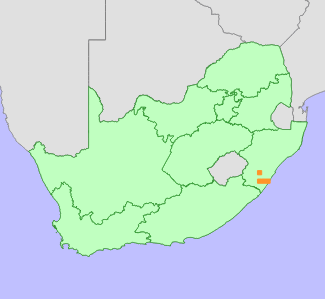|
Scientific Name | Searsia rudatisii (Engl.) Moffett |
Higher Classification | Dicotyledons |
Family | ANACARDIACEAE |
Synonyms | Rhus rudatisii Engl. |
Common Names | Ixopo Dwarf Currant (e), Rudatis's Dwarf Currant (e) |
National Status |
Status and Criteria | Endangered A2ac |
Assessment Date | 2007/05/15 |
Assessor(s) | C.R. Scott-Shaw, J.E. Victor, A.T.D. Abbott & L. von Staden |
Justification | This long-lived resprouter has lost 70-80% of its habitat to crop cultivation within the last 80 years (generation length 30 years). Three of six subpopulations are now extinct, and there is continuing decline in the habitat due to afforestation, subsistence farming and invasion by alien wattles. |
Distribution |
Endemism | South African endemic |
Provincial distribution | KwaZulu-Natal |
Range | Hela-Hela to Vernon Crookes Nature Reserve. |
Habitat and Ecology |
Major system | Terrestrial |
Major habitats | KwaZulu-Natal Sandstone Sourveld, Midlands Mistbelt Grassland, Moist Coast Hinterland Grassland, Northern Coastal Forest, Scarp Forest, KwaZulu-Natal Coastal Belt Grassland |
Description | Open grasslands, in gently sloping, or flat areas with well-drained loamy soils, 300-1300 m. |
Threats |
| The grassland habitat suited to this species is also prime agricultural (sugar cane) and forestry area. There has been 70-80% transformation of this habitat.
Three historically known populations are now locally extinct, and a further one is currently disappearing due to forestry and heavy grazing.
There is a general, ongoing decline in the habitat due to increasingly greater portions of land being converted to agriculture, mainly for subsistence farming, including small woodlots of Gum Trees that are being established. Across the valley from Highflats, where this species is already extinct, towards Umzimkhulu, tree planting permits are still being granted. Invasions by exotic wattles are also a problem (C.R. Scott-Shaw pers. comm. 2007). |
Population |
Population trend | Decreasing |
Assessment History |
Taxon assessed |
Status and Criteria |
Citation/Red List version | | Searsia rudatisii (Engl.) Moffett | EN A2ac | Raimondo et al. (2009) | | Rhus rudatisii Engl. | VU A1c,B1B2abcd,D1D2 | Scott-Shaw (1999) | | Rhus rudatisii Engl. | Rare | Hilton-Taylor (1996) | |
Bibliography |
Boon, R. 2010. Pooley's Trees of eastern South Africa. Flora and Fauna Publications Trust, Durban.
Hilton-Taylor, C. 1996. Red data list of southern African plants. Strelitzia 4. South African National Botanical Institute, Pretoria.
Moffett, R.O. 1993. Rhus. In: O.A. Leistner (ed). Flora of southern Africa 19 Part 3: Anacardiaceae, Fascicle 1:1-129. National Botanical Institute, Pretoria.
Raimondo, D., von Staden, L., Foden, W., Victor, J.E., Helme, N.A., Turner, R.C., Kamundi, D.A. and Manyama, P.A. 2009. Red List of South African Plants. Strelitzia 25. South African National Biodiversity Institute, Pretoria.
Scott-Shaw, C.R. 1999. Rare and threatened plants of KwaZulu-Natal and neighbouring regions. KwaZulu-Natal Nature Conservation Service, Pietermaritzburg.
|
Citation |
| Scott-Shaw, C.R., Victor, J.E., Abbott, A.T.D. & von Staden, L. 2007. Searsia rudatisii (Engl.) Moffett. National Assessment: Red List of South African Plants version 2024.1. Accessed on 2025/10/27 |
 Comment on this assessment
Comment on this assessment

